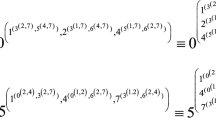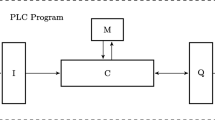Abstract
Over the last few years, embedded software synthesis has drawn much attention. However, few works deal with software synthesis for hard real-time systems considering arbitrary inter-tasks precedence and exclusion relations. Code generation for meeting all timing and resource constraints is not a trivial task. Thus, this research area has several open issues, mainly related to generation of predictable-guaranteed scheduled code. The method proposed in this paper starts from a high-level specification, and automatically translates such specification into a time Petri net model; this model is adopted for finding a feasible static schedule meeting all constraints. If found, the approach generates a scheduled code, based on the found feasible schedule. Therefore, the user just enter the specification and receives, as result, the scheduled code. Thus, all intermediary phases are hidden from the users.
Similar content being viewed by others
References
Abdelzaher TF, Shin KG (1999) Combined task and message scheduling in distributed real-time systems. IEEE Trans Parallel Distributed Syst 10(11):1179–1191
Altisen K, Göbler G, Pnueli A, Sifakis J, Tripakis S, Yovine S (1999) A framework for scheduler synthesis. In: IEEE real-time system symposium, December 1999, pp 154–163
Amnell T, Fersman E, Pettersson P, Sun H, Yi W (2002) Code synthesis for timed automata. Nord J Comput 9(4):269–300
Baker TP, Shaw A (1988) The cyclic executive model and ada. In: Proceedings of the IEEE real-time systems symposium, December 1988
Barreto R (2005) A time Petri net-based methodology for embedded hard real-time software synthesis. PhD Thesis, Centro de Informática, UFPE
Cornero M, Thoen F, Goossens G, Curatelli F (1995) Software synthesis for real-time information processing systems. Code generation for embedded processors, pp 260–279
Desel J, Reisig W (1998) Place/transition nets. In: Lectures on Petri nets I: basic models, June 1998. Lecture Notes in Computer Science, vol 1491. Springer, Berlin, pp 122–173
Fohler G (1994) Flexibility in statically scheduled hard real-time systems. PhD thesis, Technische Universität Wien, Institut für Technische Informatik, Vienna, Austria
Godefroid P (1994) Partial order methods for the verification of concurrent systems: an approach to the state-explosion problem. PhD thesis, University of Liege
Huber P, Jensen A, Jepsen L, Jensen K (1985) Towards reachability trees for high-level petri nets. Technical report Daimi PB-174, Department of Computer Science, Aarhus University
Lilius J (1998) Efficient state space search for time petri nets. In: Electronic notes in theoretical computer science, vol 18. Elsevier Science, Amsterdam
Lin B (1998) Efficient compilation of process-based concurrent programs without run-time scheduling. Design automation and test in Europe conference (DATE’98), February 1998
Marsan M, Bobbio A, Donatelli D (1998) Petri nets in performance analysis: an introduction. In: Lectures on Petri nets I: basic models, June 1998. Lecture Notes in Computer Science, vol 1491. Springer, Berlin, pp 211–256
Mok AK (1983) Fundamental design problems of distributed systems for the hard-real-time environment. PhD thesis, MIT
Sgroi M, Lavagno L, Watanabe Y, Sangiovanni-Vincentelli A (1999) Synthesis of embedded software using free-choice Petri nets. In: Design automation conference
Sieh L, Haniak P, Richardson P (2001) Implementing transient fault tolerance in embedded real-time systems. In: IEEE electronics and information technology conference
Sloan R, Buy U (1997) Stubborn sets for real-time petri nets. Formal Methods Syst Des 11(1):23–40
Valmari A (1998) The state explosion problem. In: Lectures on Petri nets I: basic models, June 1998. Lecture Notes in Computer Science, vol 1491. Springer, Berlin, pp 429–528
Wang W, Mok A, Fohler G (2005) Pre-scheduling. Real-Time Syst 30(1–2):83–103
Xu J (2003) On inspection and verification of software with timing requirements. IEEE Trans Softw Eng 29(8):705–720
Xu J, Parnas D (1990) Scheduling processes with release times, deadlines, precedence, and exclusion relations. IEEE Trans Soft Eng 16(3):360–369
Xu J, Parnas D (1993) On satisfying timing constraints in hard real-time systems. IEEE Trans Soft Eng 19(1):70–84
Author information
Authors and Affiliations
Corresponding author
Rights and permissions
About this article
Cite this article
Barreto, R., Maciel, P., Tavares, E. et al. A time Petri net-based method for embedded hard real-time software synthesis. Des Autom Embed Syst 12, 31–62 (2008). https://doi.org/10.1007/s10617-007-9011-x
Received:
Accepted:
Published:
Issue Date:
DOI: https://doi.org/10.1007/s10617-007-9011-x




